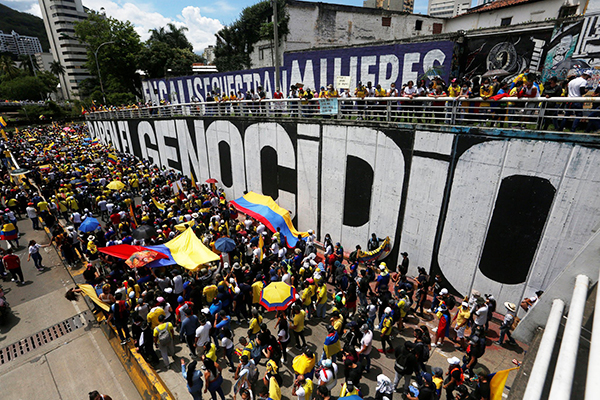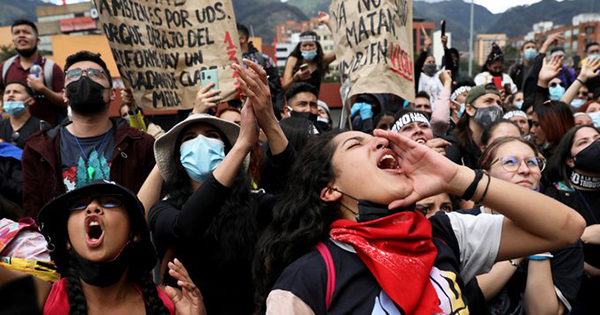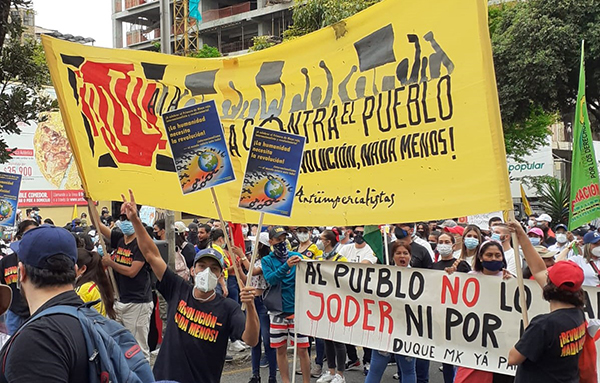Colombia: Powerful Uprisings Send Shock Waves Throughout the Hemisphere
| revcom.us

May 4, 2021, Colombia. The giant sign on the wall says “Stop the Genocide.” Photo: Photo: @ComRevCo
Massive anti-government protests have rocked the South American nation of Colombia since April 28, when Colombian president Iván Duque proposed a tax increase. People were furious at a measure that would have inflicted further punishment on a population suffering from deep and widespread poverty, high unemployment, enormous disparities of wealth and income, and a devastating third wave of the coronavirus in a country that already had one of the world’s highest infection and death rates.
A Nation in Pain
Duque backed off his proposed tax hike on May 2, but by then protests had grown in intensity, and spread across Colombia, the second most populous country in South America after Brazil. A schoolteacher at a protest in Bogotá, Colombia’s capital, said the outpourings were not just about the tax increase: “This is about corruption, inequality and poverty. And all of us young people are tired of it.” By May 5, the New York Times reported that parts of Colombian cities had been “turned into battlefields.”1
Doctors, students, union members, teachers, people from various political organizations, and people who had never before taken to the streets have been part of the uprising. Truckers have blocked major highways. The Times reported that on May 4, “demonstrators in the capital burned buses and lit over a dozen police stations on fire, singing the national anthem, yelling ‘Assassins!’ and sending officers running for their lives.”
Every day and night, tens of thousands of people have battled brutal police in the plazas and streets of Bogotá, Medellín, Cali, and other Colombian cities.2 According to the New York Times, as of May 5, the confrontations have left “at least 24 people dead, most of them demonstrators, and at least 87 missing.” Hundreds of people have been wounded by government forces, and hundreds arrested.3
The government has deployed thousands of police and soldiers trained for counter-insurgency war to suppress the protests. The Colombian defense ministry said 47,500 of its personnel were mobilized countrywide, according to the news agency France24. The first military deployment went to Cali—700 heavily armed soldiers the defense minister claimed were being used to confront “criminal organizations.” Troops were sent to Bogotá and Medellín by presidential decree.4
The police and military have shot, gassed, and beaten unarmed protesters mercilessly, while helicopters swarm overhead and tanks rumble through urban neighborhoods. A widely viewed video shows a teenager shot by a pig and bleeding to death on the street.5 Helena Osorio, a 24-year-old nurse, told a reporter at a rally in Bogotá, “I am in pain for Colombia. I am in pain for my country. All that we can do to make ourselves heard is to protest. And for that they are killing us.”
This is the fourth time in recent years that widespread uprisings have torn through Colombia, and sent political shockwaves across South America.6 In November 2019, protests that began as a national strike continued for weeks against brutalizing, murdering police, the violence inflicted on Colombia’s indigenous peoples, and for a more equitable society.
In September 2020, a wave of protests broke out when a video of the police murder of 46-year-old Javier Ordóñez went viral and enflamed people. The pigs kneeled on his back and tased him repeatedly while he pleaded “enough please, enough, no more, please” and “I am choking.” Massive protests broke out again in November 2020, on the one-year anniversary of the police assassination of Dilan Cruz, an 18-year-old protester who had been shot in the head by the police. The November 2020 protests had a significant focus on denouncing violence against women and included a “substantial feminist presence,” as a report from the Institute for the Study of the Americas indicated.7
The Bloody Hand of U.S. Imperialism
The Atlantic Council, a major imperialist “think tank,” described the U.S. as having many “strong allies” in South America, “with Colombia top among them.”8 For decades the U.S. has put enormous amounts of funding and training into the development of Colombia’s military and police. “Plan Colombia” (since updated and “re-branded” as “Peace Colombia”), was finalized during Bill Clinton’s presidency. It was an effort to develop “free markets” (meaning U.S.-imposed trade agreements that have accelerated the impoverishment of millions of Colombians) and support for the Colombian military and police.
The U.S. has funneled hundreds of millions of dollars yearly to the Colombian military, in the name of the “war on drugs.”9 Joe Biden, a senator at the time Plan Colombia was finalized, boasted during his presidential campaign in 2020 that he is “the guy who put together Plan Colombia.”10 Thousands of people were killed by the U.S.-trained forces during the years of Plan Colombia. The Washington Post reported, “Nearly 7 million Colombians (were) driven from their homes—the highest number of what the United Nations considers ‘internally displaced people’ in the world. And Colombians will continue to be maimed long after the war ends by land mines, which have killed or injured more than 11,000 people since 1990. That is second-highest number of land mines in the world after Afghanistan.”11
Plan Colombia also marked the initiation of “ESMAD” (Escuadrón Móvil Antidisturbios, Mobile Anti-Disturbances Squadron), an elite formation of “anti-riot” police whose training is largely funded by the U.S.12 ESMAD routinely inflicts and escalates violence against protesters and entire communities of indigenous and Black Colombians. After the murder of Javier Ordóñez, the Alliance for Global Justice reported that “ESMAD took to the streets and killed an additional 13 people.”13
Shockwaves
Courageous battles waged by millions of Colombians are sending shockwaves throughout Latin America. As a spokeswoman for an NGO called the Washington Office on Latin America told a reporter, “The militarization of cities, repression and violence against legitimate protests will ... increase the possibility of further rebellion. In terms of the region, as in 2019, we saw Chile inspiring Colombia, Brazil and other countries, so yes, it [protest in Colombia] could reactivate activism throughout the Americas.”14 The U.S. is desperate to keep this from happening.
The protests by masses of people in Colombia are righteous, and must be supported by anyone who yearns for a world without the misery, brutality and impoverishment caused by imperialism. Especially in the U.S., people need to support the struggle and oppose any U.S. backing for the reactionary rulers in Colombia.
1. Colombia Police Respond to Protests with Bullets, and Death Toll Mounts, New York Times, May 5, 2021. [back]
2. Chaos in Colombia as Police Appear to Beat Protesters in Videos, Newsweek, May 6, 2021. [back]
3. In Colombia, 19 Are Killed in Pandemic-Related Protests, New York Times, May 3, 2021. [back]
4. Fears of Militarization as Colombian Soldiers Confront Protesters, France 24, May 5, 2021. [back]
5. Reconstrucción de los hechos del joven asesinado en Cali. Comunidad Cuestión Pública, 5/1/21. [back]
6."Colombia: Protests, Post-Conflict, and a Pandemic," Luis Daniel González, Institute for the Study of the Americas, UNC-Chapel Hill.. [back]
7. Colombia: Protests, Post-Conflict, and a Pandemic, Luis Daniel Gonzalez, Institute for the Study of the Americas, January 5, 2021. [back]
8. The Untapped Potential of the U.S.-Colombia Relationship, The Atlantic Council, September 26, 2019. [back]
9. U.S. Funds Training of Central American Security Forces, Documents Show, Fox News, November 2, 2017. [back]
10. We Need to Reverse the Damage Trump has Done in Latin America. Biden’s Plan Won’t Cut it, The Intercept, April 18, 2021. [back]
11. The Staggering Toll of Colombia’s War With FARC, Explained in Numbers, Washington Post, August 24, 2016. [back]
12. Colombia’s ESMAD and the History of U.S. Policing, Alliance for Global Justice, November 10, 2020. [back]
13. Ibid. [back]
14. Protests Have Spread Across Colombia. Here’s Why, Washington Post, May 7, 2021. [back]

Medellin, Colombia, May 4, 2021. “Revolution and Nothing Less!” Photo: @ComRevCo

Medellin, Colombia. May 4, 2021. Photo: @ComRevCo

Medellin, Colombia. May 4, 2021. Photo: @ComRevCo

March in Queens, New York, supporting the protests of the people in Colombia. May 7, 2021. Photo: revcom.us/Revolution
Get a free email subscription to revcom.us:

